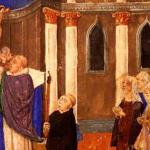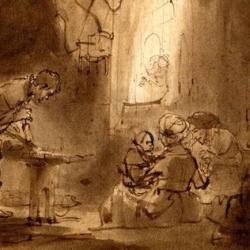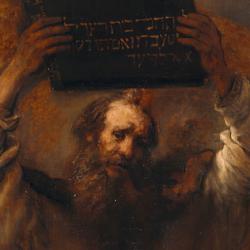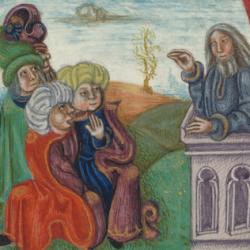When Moses ascends Sinai with the priests and elders, they see the God of Israel resting his feet on a sapphire pavement above them as they eat and drink (Exodus 24). The scene has a triadic structure: mountain, pavement, and Yahweh above.
That structure is replicated in the ark of the covenant (Exodus 25). The ark proper is a wooden box, overlaid with gold inside and out. The lid is a solid gold slab, and a cherubim throne is worked into the gold slab above. Thus: Box below, lid above, and the throne of Yahweh’s glory above. If one could squeeze into the box, and could see through gold, he’d see the feet of God resting on His ark-footstool.
The ark thus replicates the scene of Sinai: Mountain = box; pavement = lid; Yahweh = Yahweh (“He is who He is”).
And it also replicates the entire structure of the tabernacle, with its triple structure of court, holy place, and most holy place. We can extend our series of equations: Mountain = box = courtyard; pavement = lid = holy place; Yahweh = Yahweh = Yahweh’s throne room/most holy place.
Among other things, that helps us grasp the symbolism of the courtyard. It’s surrounded by a curtain (Exodus 27:9-19) hung on pillars set into sockets of bronze. It’s a mountaintop, the billowing curtains representing the billowing clouds of the sky. Entering the court is like following Moses in his ascent into the cloud at the top of Sinai. It’s like climbing back up to the high place of Eden.
The description of the ark gives significant attention to the rings and poles used to transport it (Exodus 25:12-15). Four rings are at the “four feet” of the ark, and the gold-covered poles pass through the rings at the feet. When those burly Levites hoisted the ark on their shoulders, it would be above their heads. Raising the ark, they were lifting up Yahweh’s throne, so that he towered above them in procession.
The other furniture of the tabernacle also has rings for poles – the bronze altar of ascensions (Exodus 27:4), the table of showbread (25:26-27), the incense altar (30:3-4). Exodus doesn’t tell us explicitly where all these rings were, but there’s enough data to get the basic picture.
The rings of the table are just beneath the rim that surrounds the table’s surface. The rings of the golden altar are on the “walls” of the altar with the molding above, apparently indicating that the rings were located somewhere in the middle of the altar.
When those burly Levites did their hoisting, we’d have this situation: The table would be roughly level with their heads; the golden altar would be somewhat above their heads; the ark would be highest above their heads, with nearly the entire ark rising above them.
Thus: the table is high, the altar higher, the ark highest. In procession, these three pieces of furniture would look like a stairstep moving up toward the high place of Yahweh’s throne.
And not only in procession. The tabernacle is a tent, but its walls are made of wooden boards overlaid with the curtains of the tabernacle itself. These boards are held together with bars of acacia wood, overlaid with gold (Exodus 26:26-30). They are the same construction as the poles used by the Levites to transport the tabernacle furnishings, and they run through rings that are set in the walls. If you had Levites burly and big enough, they could pick up the entire tabernacle and carry it away.
The poles remain in the ark even after the ark is deposited in the most holy place (Exodus 25:15). The idea seems to be that the poles of the ark architecturally match the poles that hold the walls together. Literally, the ark is set on the ground on its four feet; symbolically, it’s suspended by poles.
And if we imagine that the poles for the other furniture also remain in their rings, then we have – in idea, not in physical reality – the stair-step effect when the tabernacle is at rest, just as we do when the tabernacle is in procession. The furniture of the tabernacle is, by its architectural symbolism, floating in midair, and the priests make a a symbolic ascent as they moves from the court to the table to the altar to the ark. The priests are like cherubs, ministering in the space of the firmament.
This conception is underscored by the “stories” of the tabernacle. The pillars of the courtyard are set in bronze sockets (Exodus 27:9-10) and have hooks of silver at the top (27:17). The boards that make up the tabernacle proper are set in sockets of silver (26:19) and are covered with gold.
As Vern Poythress has pointed out (Shadow of Christ in the Law of Moses), this suggests that the zones of the tabernacle are – in architectural symbolism – stacked on top of each other: Bronze at the bottom; a silver layer in the middle; gold above.
We can add this to our triads above: Mountain = box = courtyard = bronze; pavement = lid = holy place = silver; Yahweh = Yahweh = Yahweh’s throne room/most holy place = gold.
And that gives us quite a bit to work with as we puzzle over the rest of the tabernacle.











